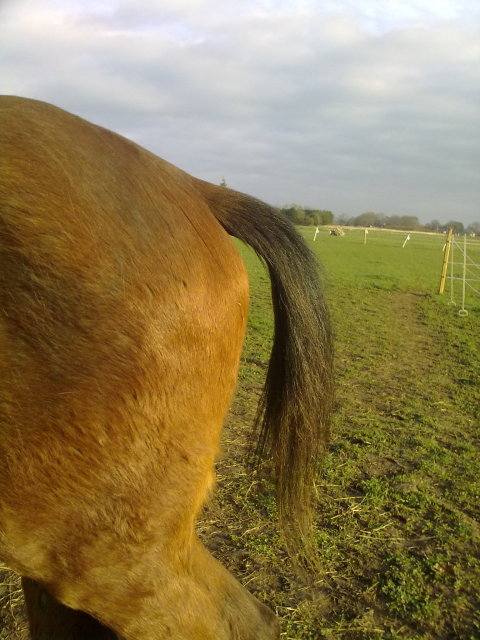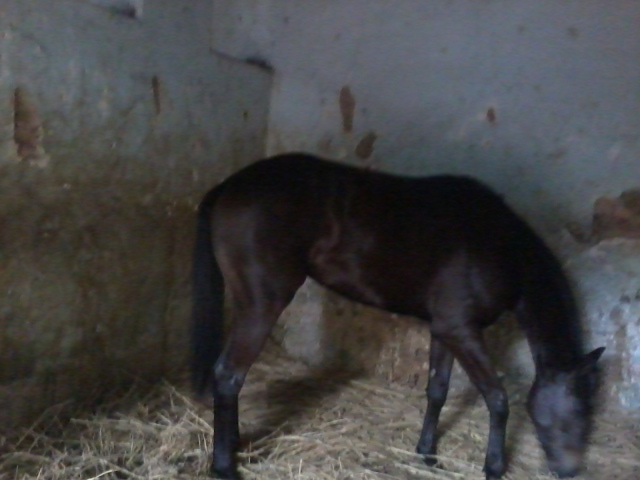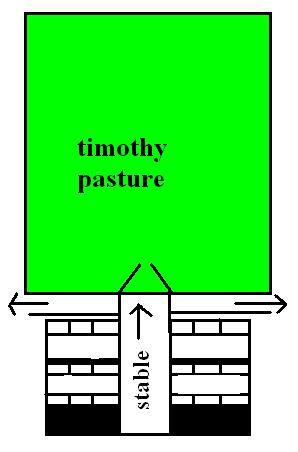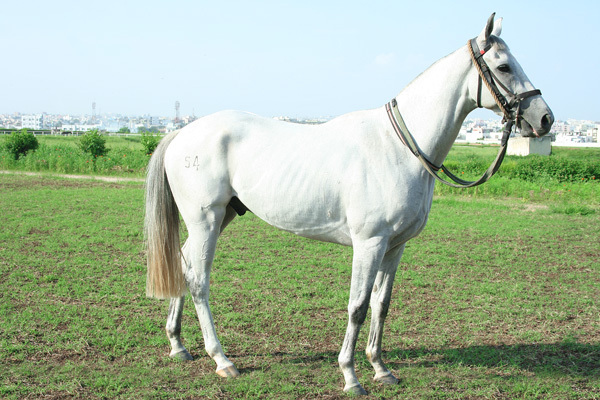QuestionHi there,
I was wondering if you could help me out. I have a yearling (as of March 25) Kiger Mustang Gelding that I would like to put out to grass in my 5 acre pasture with my other two horses for the summer/fall, but I am concerned that he will be too high strung and 'hot' if I do so. I am also concerned about his health. He eats nothing but grass hay, and seems to keep on weight okay, although he is slightly underweight. I would like to get his weight up, unfortunately, if i feed him grain of any kind, or any amount, his energy goes absolutely through the roof to the point of being almost unmanageable. And, last summer, I tried to feed him a very small amount of alfalfa at one feeding and he got so gassy that he colicked. He has very little activity/excercise but lives with two other adult horses in a 1 acre paddock - so he has plenty of space to move about. When on just grass hay, his energy level is perfect - he is not groggy or drowsy, but not dangerously energetic. Is there a way to get his weight up a bit without giving him any extra energy, and would grazing him on my lush green pasture make him hot, and could it be dangerous after he colicked on just alfalfa? It seems to me that his system does not handle rich forage very well, but it could have been a fluke thing, it's hard to tell. He was quite young then, probably about 5 months... any advice? I really appreciate it!
Thanks so much!
Peace & Love,
Hannah
AnswerHi Hannah,
What a great question this is! It seems you have a bit of a handful to work with but I'm sure I can give you some suggestions that will greatly help.
Your concern over your young horse's 'hot' attitude is certainly not imaginary and given the situation as you explain it, is to be expected. It is interesting how some breeds of horses, and sometimes the bloodlines within some breeds, have trouble handling rich/starchy feeds. The exact problem they are having is with their ability to process non-structural carbohydrates and the effect that ultimately has on both their 'hot attitudes' and their digestive systems. Often times the ones with hot attitudes from the NSCs are also the ones most prone to gas colic.
NSCs in feed are found predominantly in grains (especially cereal grains like corn, barley and oats) and the leaves of legume forages like alfalfa and clover. When the horse consumes these NSCs they are (should be) broken down into glucose or simple sugars in the stomach and absorbed through either the stomach or small intestine wall into the bloodstream where they travel to the liver to be converted entirely into glucose. All of this glucose creates a sugar rush in the blood stream that exists until enough insulin is released to cause it all to be stored in muscle or as fat. The sugar rush can be likened to a young child on chocolate, and the horse will exhibit 'hot' attitude. If the diet is rich in NSCs, so much so that the stomach hasn't time to process it all, they travel to the hind gut of the horse where very bad things happen to it...most especially gas colic. Large volumes of NSC in the hindgut causes colic, but consistently low levels simply creates an uncomfortable acidic hind gut which can also lend to bad attitude. Most of these horses are also deemed 'hard keepers'. I don't believe there is really any such thing as a hard keeper, just a bad hindgut.
This is starting to sound like a lengthy response but there is a bit more that you need to know. The NSC in the hindgut prevents the proper fermentation of the good structural carbohydrates (or fiber) which would create a by-product called Thiamine or Vit. B1. Thiamine would normally be absorbed back to the blood stream where it would help with carbohydrate metabolism...or the clearing of glucose from the bloodstream (which cuts down on sugar rushes). But in the case of too much NSC in the diet this Thiamine doesn't get produce, absorbed or used. A bit of a vicious circle. Several years ago I would have simply suggested that you start adding Thiamine to the diet and this would help quiet your horse. Of course this will work wonders but is a bit of a patch solution as it does not address the NSC or hindgut issue.
So to make a short answer long...your horse could probably go out on GRASS pasture without a huge danger of 'hot' attitude but I would be a little concerned if there is a lot of legume (alfalfa or clover) in it. I would really like to see you fix the horse's digestive system which could very well help eliminate the problem altogether. If you would like to try this, here are my suggestions. For the short term find some Thiamine to feed to your horse as it does control 'hot' attitude a couple of different ways. Because it is a B vitamin it is safe to feed and it is water soluble so any extra in the system will be peed out. There are a lot of companies selling it for horses so you should be able to find it at a local feed store that caters to horses or at some tack shops. My favorite is from 'Basic Equine Nutrition' and they have an online catalog that you can take a look at. If you can get the hindgut fixed you should only need to feed the Thiamine for a month or so. To fix the hindgut itself I would strongly suggest 'Lifeforce Formula' from Alltech. It can be quite pricey but well worth the investment...and I would think you should only need to feed it for 2 months. If that is a bitt too expensive for you, try a probiotic powder that includes a combination of yeast and mycotoxin binder, and again use it for approximately 60 days. A lot of time you need only to jump start the hindgut and it begins to look after itself.
And if you want or need to feed a grain of some sort you are going to want to be sure to feed something that has no added starch. There will always be a little bit present but ensure that the formulation has added any in the form of corn, barley, oats, wheat, etc. A good quality high fat, high fiber feed is your best choice...just be sure to ask to see the ingredient list first as some sneak in starch.
I've seen this situation many times and have used this very approach with a tremendous amount of success. If there is anything else I can do please let me know.
Thanks, Corlena

 Horse Hair loss
Question
Tail
2 year old mare Appaloosa X shire
Horse Hair loss
Question
Tail
2 year old mare Appaloosa X shire
 raw milk for under developed baby horses
Question
under developed
hello maam. top trainer
raw milk for under developed baby horses
Question
under developed
hello maam. top trainer
 Senior Winter Care
Question
Doc and I
My horse is 29 and will turn
Senior Winter Care
Question
Doc and I
My horse is 29 and will turn
 stables inside my pasture
Question
stables inside my past
hello maam, can i set l
stables inside my pasture
Question
stables inside my past
hello maam, can i set l
 guessing the horse weight seeing it
Question
guess weight
hello maam. this is a thor
guessing the horse weight seeing it
Question
guess weight
hello maam. this is a thor